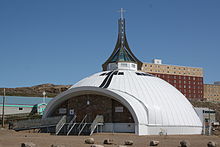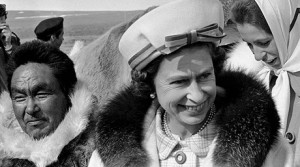
The Earl and Countess of Wessex are greeting by Nunavut Premier Eva Aariak in the presence of Commissioner Edna Elias. Photo credit: Government of Nunavut
The Earl and Countess of Wessex arrived in Iqaluit, the capital of the territory of Nunavut last night on the second stop of their week long working visit to Canada. Although Prince Edward has visited Canada on thirty-two previous occasions, and is the only member of the royal family apart from the Queen to have a Canadian Private Secretary, 2012 marks his first visit to Nunavut. According to Nunavut Premier Eva Aariak, the territory was the Earl and Countess of Wessex’s first choice of destination on their 2012 working visit.
The royal couple have a full itinerary of events during their time in Nunavut. The program began this morning at 10:30am with a ceremony at the Nunavut legislative building to honour sixteen long serving members and employees of the Royal Canadian Mounted Police. The Earl of Wessex is Honorary Deputy Commissioner of the RCMP and takes a close interest in the organization. Five of the honourees will receive Diamond Jubilee medals. After a lunch given by The Honourable Edna Ekhivalak Elias, the Commissioner of Nunavut, at her Residence, the Earl and Countess will attend a service of dedication at St. Jude’s Anglican Cathedral.
The site of the original St. Jude’s cathedral was dedicated by Queen Elizabeth II during her 1970 tour of the Canadian arctic. The unique building, designed to resemble an igloo, was severely damaged by fire in 2006 and has recently been rebuilt. The presence of the Earl and Countess of Wessex at the dedication of the new building continues to the royal connection to the seat of the Anglican Diocese of the Arctic. At 5:30pm, the royal couple will attend a reception for community leaders and volunteers at the Nunatta Sunakkutaangiit museum with Commissioner Elias. The museum is housed in an old Hudson Bay Company Warehouse and contains exhibitions of Inuit sculpture, prints and artifacts.
The people of Iqaluit will have the opportunity to meet the Earl and Countess of Wessex at a community feast this evening at at St. Jude’s Anglican Parish Hall. The Hall was the setting of Anglican religious services after the destruction of the original St. Jude’s cathedral and still serves as a community centre. After spending the night in Iqaluit, the Earl and Countess will visit the nursing program at Nunavut Arctic College before returning to Ontario for the remainder of their visit. The college was founded in 1968 as an Adult Vocational Training Centre by the government of the Northwest Territories and became Nunavut Arctic College when Nunavut became a separate territory in 1999. The nursing program operates in a partnership with Dalhousie University in Halifax, Nova Scotia.
Royal visits to Canada’s territories are not only an opportunity for the Queen and her family to engage with the people and institutions of the Yukon, Northwest Territories and Nunavut but are politically significant as direct evidence of Canadian sovereignty over the Arctic. During the Cold War, Canada’s territories were strategically significant because of their proximity to both the United States and the Soviet Union.
Queen Elizabeth II’s 1970 tour of the Arctic was a direct statement of Canadian sovereignty over the region during a period when the United States was questioning Canada’s ability to effectively populate and defend its northern territories. Instead of only visiting the territorial capital cities of Whitehorse and Yellowknife, as she had done during her 1959 cross Canada tour, the Queen, accompanied by the Duke of Edinburgh, Prince Charles and Princess Anne traveled north of the Arctic Circle to what are now the communities of Inuvik and Tuktoyaktuk. Her presence symbolized Canada’s authority over these regions.
In the twenty-first century, Canada is once again facing challenges to its sovereignty over the Arctic. As global temperatures rise, the Northwest Passage through the islands of Nunavut and the Northwest Territories is increasingly accessible to sea going vessels. Canada claims the Northwest Passage as part of its internal waters according to the United Nations Convention on the Law of the Sea. The other Arctic Nations, most notably the United States, argue that the Northwest Passage is part of international waters and cannot be closed to shipping traffic by the Canadian government.
As these debates unfold, royal visits to the Arctic territories continue to reinforce Canada’s sovereignty over the region. The presence of the Earl and Countess of Wessex in Iqaluit had broader political significance in addition to the royal couple’s personal engagement with the people and institutions of Nunavut.


